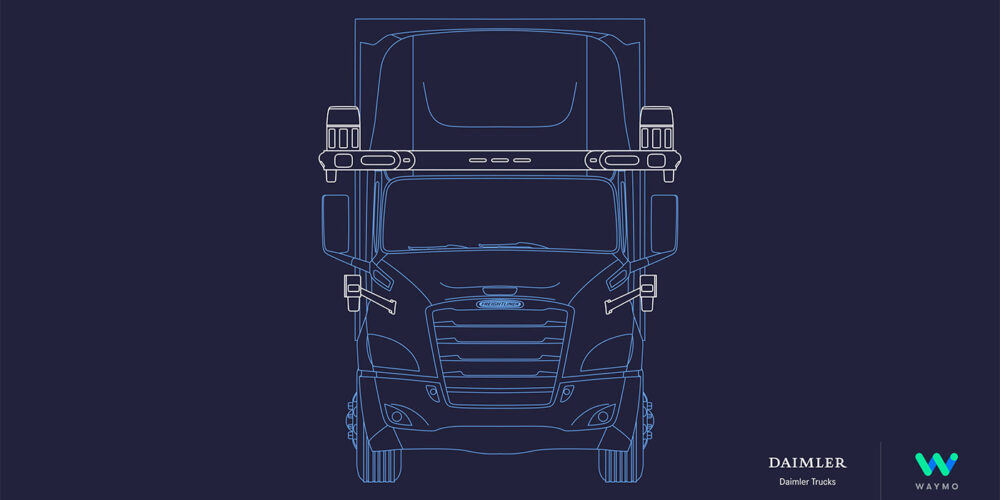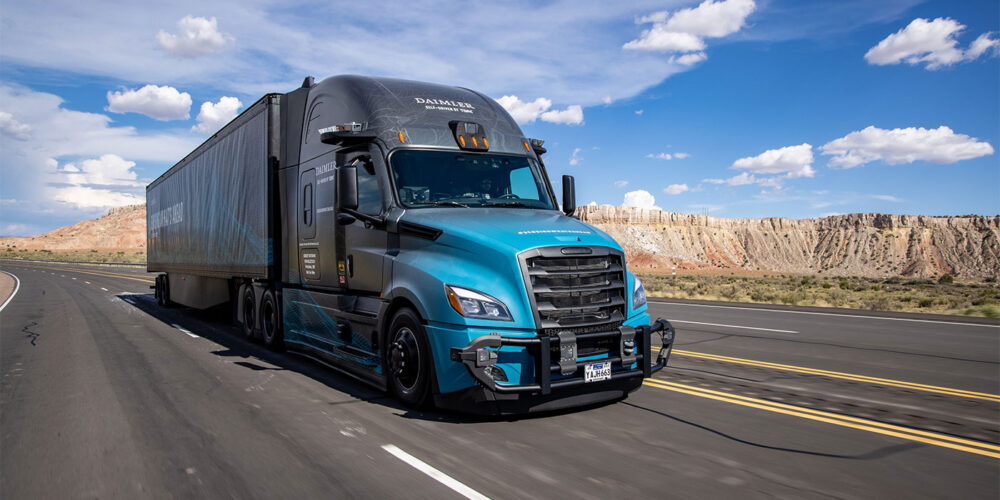Daimler Truck North America (DTNA) just passed another mile marker on the road to Level 4 autonomous trucks, but this time it wasn’t because of a technology demo. Sitting down with Joanna Buttler, head of the Global Autonomous Technology Group, Daimler Truck AG, and Peter Vaughan Schmidt, chief executive officer, Torc Robotics, it became clear that the OEM and its “independent subsidiary” are serious about an autonomous truck reality because they have a plan for the manufacturing, application roll out and after-sales support that they say will make autonomous trucking a reality on U.S. highways by the end of 2029.
The two executives fielded serious questions on practical applications, equipment and system requirements, and service and support responsibility. So here are the three autonomous truck takeaways to understand why it might be time to take the technology seriously.
1. Redundancy
Let’s start with the least exciting aspect (from a headline-grabbing POV) because it might just be the most important. To manufacture Level 4-capable heavy-duty autonomous truck chassis, DTNA had to redesign its truck from the ground up.
“Take the brake system, for example,” Buttler began, “In this case, instead of just having one ECU, we have two ECUs, using the secondary–the redundant one–as a backup. The steering system has redundancy. We have two steering motors instead of one. We are the first ones to actually launch a 48-volt power net system in the U.S. because we need to generate enough power to power the autonomous driving compute system and still have enough power for the rest of the vehicle. This is something that we have developed in-house in the U.S.”
This isn’t a tweaking of current Freightliner Cascadia systems. The redesign ensures redundancy for safety critical systems while meeting manufacturing and service ability requirements for DTNA and its partners, Torc and Waymo–more than 1,500 requirements, in fact, that are different from a standard on-highway Freightliner Cascadia chassis. That number includes more than a dozen of critical hard-part components that are physically on the truck, and the rest of the requirements come from software.
“Cybersecurity is a big factor that is needed to produce a safe and reliable platform,” she said. “Utilizing state-of-the-art cybersecurity methodologies to secure and encrypt the messages that are on the CAN-BUS prevents outside threats. Another important topic is to ensure the entire system safety with functional safety processes and evaluations.”
Currently, the Freightliner autonomous truck chassis is nearing “C-sample maturity” and is getting closer to series production,” according to Buttler.
Once the chassis is manufactured, one of two things happens depending on the autonomous truck developer. In the case of Torc, the autonomous truck components it’s responsible for–LiDar, radar, cameras, to name a few–are installed and integrated on the DTNA manufacturing line. Think of it as an integrated, proprietary system much like the Detroit powertrain as Daimler Truck holds a majority stake in Torc Robotics. It also has an autonomous truck partnership with Waymo, formerly known as the Google Self-Driving Car Project, in which it delivers the autonomous truck chassis to the company to enable Waymo to install its system on the truck.
“Waymo installs their system post-factory,” Buttler confirmed. “It’s an integrated system, but we are not actively installing it on their behalf at this point in time.”
So then the question is: Why two systems? That brings us to our second point.
2. Virtual Drivers
Torc and Waymo are just two names in a rapidly developing autonomous trucking market. All of them are offering a “Virtual Driver”–the software and sensor suite that enables autonomous trucks. It literally drives the truck, and the developer of your platform selection is as important as any other equipment you depend upon. Think of it like selecting an engine or tire supplier–fuel efficiency and after-sales service and support will fall on the shoulders of your autonomous truck Virtual Driver developer.
“Competition is healthy and I’m a big, big fan of competition,” Schmidt said. “The cool thing that we are doing is that the Torc Virtual Driver will be optimized only for the Freightliner Class 8 truck.”
“We really believe that our customers want and need a choice of Virtual Drivers,” Buttler added. “They both will meet certain needs for the drivers and for our customers. They’re both still developing their technology, and we will ultimately see in which area they will play. There could be differences in the application of each of the Virtual Driver…then whomever has the best performance, best efficiency, best uptime will be the leading offering in the market.”

Consider fuel efficiency. Let’s not think of Level 4 autonomous trucks as a vague, sweeping, “The truck drives itself!” technology. In reality, it’s the next step in the evolution from Level 2 advanced driver assistance systems (ADAS) that make up a majority of DTNA Class 8 truck builds today with Detroit Assurance Suite of Safety Systems 5.0. There’s a safety benefit, but there’s also a fuel efficiency advantage as intelligent powertrain management, lane-keep assist and adaptive cruise controls help to bring a higher level of consistency to truck operation, thus saving fuel. Level 4 autonomous truck Virtual Drivers aim to take fuel efficiency even further by providing further consistent truck operation.
“In principle, a human driver can always beat a system because, first of all, the system is consuming energy, but the difference is that the system can run the truck at super high performance around the clock, more or less 20 hours per day. It won’t need a break. It drives smoothly and consistently. There’s no rush against the system running out of your Hours of Service limits, and you want to speed up. You could get this fuel efficiency with a human driver, it’s just harder to get with human drivers.”
It’s worth noting that Federal Motor Carrier Safety Administration (FMCSA) has not issued any rulemaking related to autonomous truck hours of service, and Level 4 autonomous truck operation will still require a driver onboard to monitor the system while it is in autonomous mode. The system will not be in autonomous mode 100% of the time, according to Daimler Truck and Torc. (More on application rollout in a minute.)
The other important aspect in autonomous Virtual Driver selection is the after-sale service and support model.
“Even though it’s autonomous, the basic laws of trucking do not change,” Schmidt said. “Reliability first. If there’s downtime, then it should be planned downtime. That’s a huge contributor to the system’s economics. We have a plan for what is needed for autonomy and what is also needed for reliability. Parts will break. A truck has a rough life, driving a lot of miles. We are investing in predictive maintenance so that you can turn unplanned into planned downtime. Then comes parts availability and training technicians.”
Service and support responsibility for the software falls on the shoulders of the Virtual Driver supplier. Back to the example of Daimler Truck’s integration with Torc and partnership with Waymo, Buttler confirmed the plan that in the case of warranty issues, for example, DTNA would be responsible for components on the truck chassis with both suppliers. When it comes to warranty on the Torc Virtual Driver system, DTNA would also be responsible for supporting the hardware components. Service would be handled by DTNA’s service network. In Waymo’s case, warranty responsibility for Waymo Via (its name for its commercial truck Virtual Driver) software and components would fall on Waymo’s shoulders, Buttler noted.

Of course, Torc touts the advantages of integration, but it’s a proprietary Freightliner system whereas Waymo’s Virtual Driver aims to be available across nameplates. J.B. Hunt and Waymo have shown off Waymo Via outfitted onto a competing truck brand. Ultimately the choice rests with you, the fleet, but it’s important to understand everything that comes along with that choice. It goes way beyond a slick technology demo.
3. Autonomous Application
Buttler and Schmidt agreed that bringing Level 4 autonomous operation to trucking will need to be a measured rollout to specific applications that will grow with scale over time.
“The U.S. is one of the most favorable markets due to various conditions,” Buttler said. “The overall route network consists of almost 47,000 miles of interstate highways in the US that we are targeting to automate; we’re targeting hub-to-hub, on-highway driving to start. We’re keeping the use case less complex and there’s huge potential there.”
On top of that, a driver is still needed in the truck for first- and last-mile type operations. Currently the Torc Virtual Driver would be activated when the system indicates its ready once the truck has reached the highway (which we experienced in our Torc Level 4 truck ride-along last year.). Make no mistake, drivers will continue to play a pivotal role in truck operation for the foreseeable future even when Level 4 autonomous trucks are on the road.
Then there’s the pricing model. The jury is still out as to how this will all work from a purchase point of view–there could be a subscription model, for instance. And purchase models may differ from autonomous Virtual Driver provider to provider.
“There will be multiple models,” Schmidt confirmed. “Just like today with a truck. You can buy a truck, you can lease a truck. Let’s just say, it won’t be just one model.”
Virtual Driver software updates will be a reality, just as they are with over-the-air engine software updates on today’s trucks.
Of course there are also questions of regulations and public acceptance that will still need to be answered in the coming years as DTNA and Torc charge toward availability by end of the decade. For their part, the OEM and its partners are moving the conversation beyond splashy, attention-grabbing headlines and into the world of reliable business conversations to make autonomous truck equipment reality.













